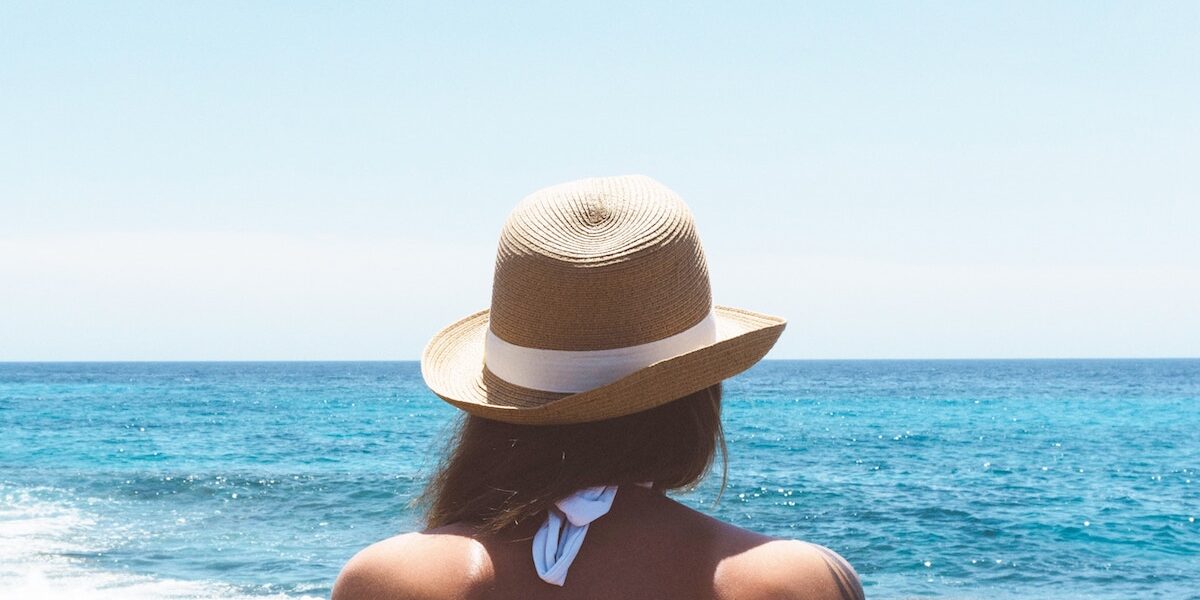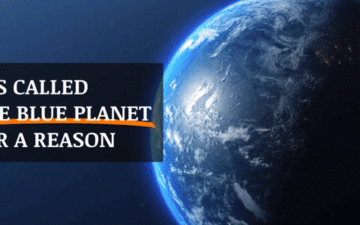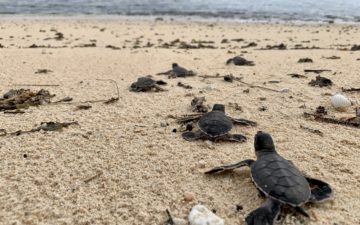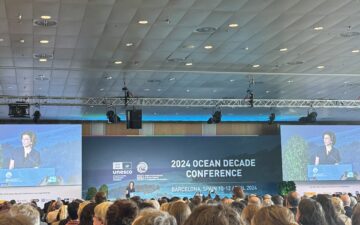By Jessie Neumann, Communications Assistant
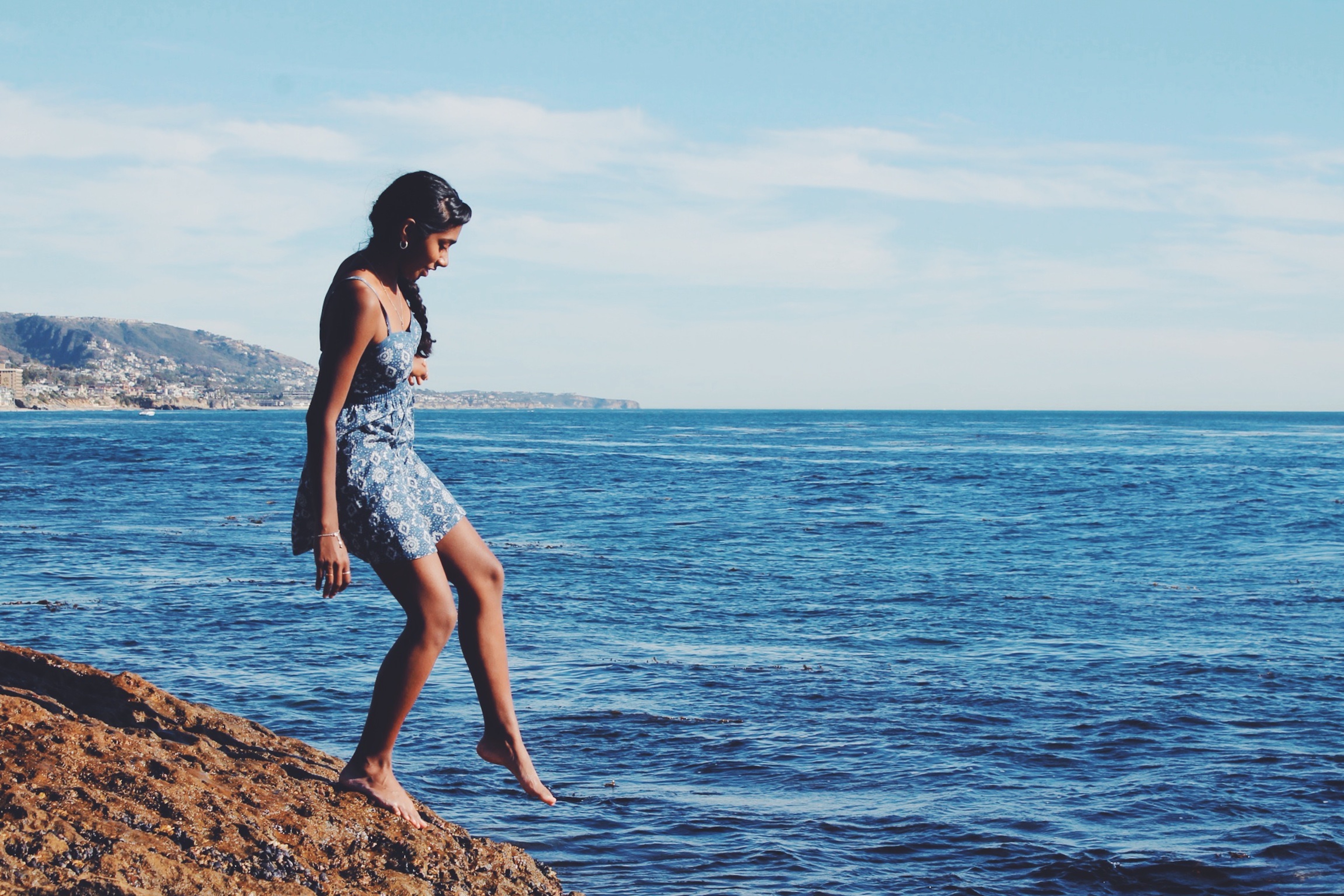
March is Women’s History Month, a time to celebrate the social, economic, cultural and political achievements of women! The marine conservation sector, once dominated by men, now sees more and more women joining its ranks. What is it like to be Woman in the Water? What can we learn from these passionate and committed individuals? To celebrate Women’s History Month, we interviewed several female conservationists, from artists and surfers to authors and field researchers, to hear about their unique experiences in the marine conservation world, both below the surface and behind the desk.
Use #WomenInTheWater & @oceanfdn on Twitter to join in the conversation.
Our Women in the Water:
- Asher Jay is a creative conservationist and National Geographic Emerging Explorer, who uses groundbreaking design, multimedia arts, literature, and lectures to inspire global action to combat illegal wildlife trafficking, advance environmental issues, and promote humanitarian causes.
- Anne Marie Reichman is professional water sports athlete and Ocean ambassador.
- Ayana Elizabeth Johnson is an independent consultant for clients across philanthropy, NGOs, and startups. She has her PhD in marine biology and is the former Executive Director of The Waitt Institute.
- Erin Ashe co-founded the research and conservation non-profit Oceans Initiative and just recently received her PhD from the University of St. Andrews, Scotland. Her research is motivated by a desire to use science to make tangible conservation impacts.
- Juliet Eilperin is an author and The Washington Post’s White House Bureau Chief. She is the author of two books — one on sharks (Demon Fish: Travels Through the Hidden World of Sharks), and another on Congress.
- Kelly Stewart is a research scientist working in the Marine Turtle Genetics Program at NOAA and leading the Sea Turtle Bycatch project here at The Ocean Foundation. One major field effort that Kelly leads focuses on genetically fingerprinting hatchling leatherback turtles as they leave the beach after emerging from their nests, for the purpose of determining the age to maturity for leatherbacks.
- Oriana Poindexter is an incredible surfer, underwater photographer and is currently researching the economics of global seafood markets, with an emphasis on seafood consumer choice/willingness to pay in markets in the US, Mexico and Japan.
- Rocky Sanchez Tirona is the Vice President of Rare in the Philippines, leading a team of roughly 30 people working on small-scale fisheries reform in partnership with local municipalities.
- Wendy Williams is the author of Kraken: The Curious, Exciting, and Slightly Disturbing Science of Squid and just recently released her newest book, The Horse: The Epic History.
Tell us a little about your job as a conservationist.
Erin Ashe – I’m a marine conservation biologist — I specialize in research on whales and dolphins. I co-founded Oceans Initiative with my husband (Rob Williams). We carry out conservation-minded research projects, primarily in Pacific Northwest, but also internationally. For my pHD, I studied white-sided dolphins in British Columbia. I still carry out work in this field, and Rob and I partner on projects to do with ocean noise and bycatch. We also continue to study the anthropogenic impacts on killer whales, both in US and Canada.
Ayana Elizabeth Johnson – Right now I’m an independent consultant with clients across philanthropy, NGOs, and startups. I support the development of strategy, policy, and communications for ocean conservation. It’s really exciting to think about ocean conservation challenges and opportunities through these three very different lenses. I’m also a resident at TED working on a talk and some articles about the future of ocean management.
Kelly Stewart – I love my job. I’ve been able to combine my love of writing with the practice of science. I study sea turtles mainly now, but I’m interested in all natural life. Half the time, I’m in the field taking notes, making observations, and working with sea turtles on the nesting beach. The other half of the time I’m analyzing data, running samples in the lab and writing papers. I work mostly with the Marine Turtle Genetics Program at NOAA – at the Southwest Fisheries Science Center in La Jolla, CA. We work on questions that directly affect management decisions by using genetics to answer questions about sea turtle populations – where individual populations exist, what threatens those populations (e.g., bycatch) and whether they are increasing or declining.
Anne Marie Reichman – I am a professional water sports athlete and Ocean ambassador. I have trained others in my sports since I was 13 years old, what I call “sharing the stoke”. Feeling the need to connect with my roots again (Anne Marie is originally from Holland), I started organizing and racing the SUP 11-City Tour in 2008; a 5 day international paddle event (138 miles through the canals of the north of Holland). I get a lot of my creativity from the ocean itself, shaping my own surfboards including environmental materials when I can. When I collect trash from the beaches, I often reuse things like driftwood and paint it with my “surf-art, flower-art and free flow.” Within my job as a rider, I focus on spreading the message to “Go Green” (“Go Blue”). I enjoy participating in beach clean ups and speaking at beach clubs, junior lifeguards and schools to emphasize the fact that we need to make a difference for our planet; starting with OURSELVES. I often open the discussion with what we can each do for our planet to create a healthier future; how to reduce trash, where to reuse, what to recycle and what to buy. Now I realize how important it is to share the message with everyone, because together we are strong and we can make a difference.
Juliet Eilperin – [As The Washington Post’s White House Bureau Chief] it certainly has become a little more challenging to write about marine issues in my current perch, although I have found different ways of exploring them. One of them is that the President himself occasionally delves into marine related issues particularly in the context of National Monuments, so I’ve pushed very hard to write about what he’s doing to protect oceans in that context, particularly as it came up with the Pacific Ocean and his expansion of the existing national monuments there. And then, I try other ways in which I can marry my current beat to my old one. I covered the President when he was on vacation in Hawaii, and I used that opportunity to actually go to Ka’ena Point State Park, which is on the norther tip of Oʻahu and provide the lens into what the ecosystem looks like beyond the northwestern Hawaiian Islands. That gave me a chance to examine the ocean issues at stake in the Pacific, close to the President’s home, and what that says about his legacy. Those are some of the ways that I’ve been able to continue to explore marine issues, even as I cover the White House.
Rocky Sanchez Tirona – I’m the VP for Rare in the Philippines, which means I oversee the country program and lead a team of roughly 30 people working on small-scale fisheries reform in partnership with local municipalities. We focus training local conservation leaders on combining innovative fisheries management and market solutions with behavior change approaches — hopefully leading to increased fish catch, improved livelihoods and biodiversity, and community resilience to climate change. I actually came to conservation late — after a career as an advertising creative, I decided I wanted to do something more meaningful with my life — so I shifted focus towards advocacy and social marketing communications. After a great 7 years doing that, I wanted to get into the program side of things, and go deeper than just the communications aspect, so I applied at Rare, which, because of its emphasis on behavior change, was the perfect way for me to get into conservation. All the other stuff — science, fisheries and marine governance, I had to learn on the job.
Oriana Poindexter – In my current position, I work on blue market incentives for sustainable seafood. I research the economics of seafood markets to understand how to incentivize consumers to select responsibly harvested seafood that can directly aid the conservation of marine biodiversity and critically endangered species. It’s exciting to be involved in research that has applications in the ocean and at the dinner table.
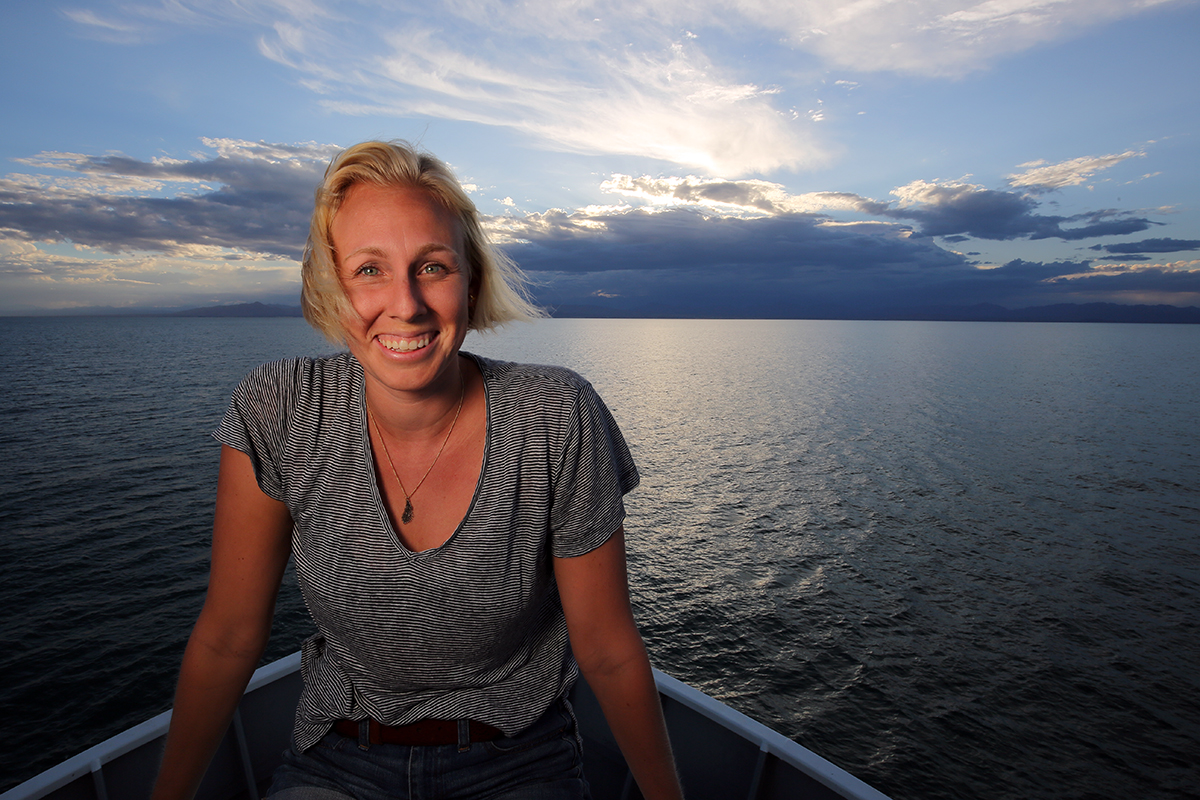
What sparked your interest in the ocean?
Asher Jay – I think I wouldn’t have wound up on this path had I not had early exposure or had been sensitized to wildlife and animals from an early age which my mother did. Volunteering locally as a kid helped. My mother always encouraged I go on trips abroad…I got to be part of turtle conservation, where we would relocate hatcheries and watch them make their way to the water when they hatched. They had this incredible instinct and need to be in the habitat they belong to. And that’s deeply inspiring… I think that is what got me into where I am in terms of of the commitment and the passion for wilderness and wildlife…And when it comes to creative arts, I think the constant access to visual instances in this world is one way in which I have been encouraged to have this position in favor of design and communication. I see communication as a way to bridge gaps, shift cultural consciousness, and mobilize people to things that they may not know of. And I just love communication as well! …When I see an ad I don’t see the product, I look at how the composition brings this product to life and how it sells it to the consumer. I think of conservation the same way that I think of a beverage like coca cola. I think of it as a product, that it’s marketed effectively if people know why it’s important …then there is a real way to sell conservation as an interesting product of one’s lifestyle. Because it should be, everyone is responsible for the global commons and if I can use the creative arts as a way of communication to all and empower us to be part of a conversation. That is exactly what I want to be doing….I apply creativity towards conservation.
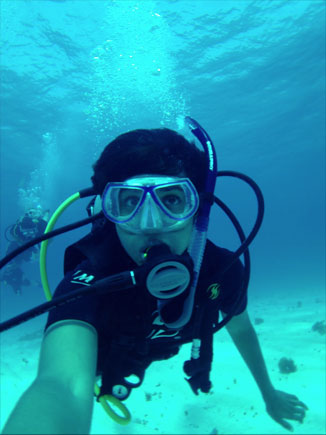
Erin Ashe – When I was about 4 or 5 years old I went to visit my aunt on San Juan Island. She woke me up in the middle of the night, and took me out on the buff overlooking Haro Straight, and I heard the blows of a pod of killer whales, so I think the seed was planted at a very young age. Following that I actually thought I wanted to be a veterinarian. That kind of shifted into a real interest in conservation and wildlife when killer whales were listed under the endangered species act.
Rocky Sanchez Tirona – I live in the Philippines – an archipelago with 7,100 plus islands, so I’ve always loved the beach. I’ve also been diving for more than 20 years, and being near or in the ocean is really my happy place.
Ayana Elizabeth Johnson – My family went to Key West when I was five. I learned how to swim and loved the water. When we took a trip on a glass bottom boat and I saw the reef and colorful fish for the first time, I was enthralled. The next day we went to the aquarium and got to touch sea urchins and sea stars, and I saw an electric eel, and I was hooked!
Anne Marie Reichman – The ocean is a part of me; my sanctuary, my teacher, my challenge, my metaphor and she always makes me feel at home. The ocean is a special place to be active. It is a place that allows me to travel, compete, meet new people and discover the world. It is easy to want to protect her. The ocean gives us so much for free, and is a constant source of happiness.
Kelly Stewart – I always had an interest in nature, in quiet places and in animals. For a time while I was growing up, I lived on a little beach on the shores of Northern Ireland and exploring tidepools and being alone in nature really appealed to me. From there, over time, my interest in marine animals like dolphins and whales grew and progressed into an interest in sharks and seabirds, finally settling on sea turtles as a focus for my graduate work. Sea turtles really stuck with me and I was curious about everything that they do.
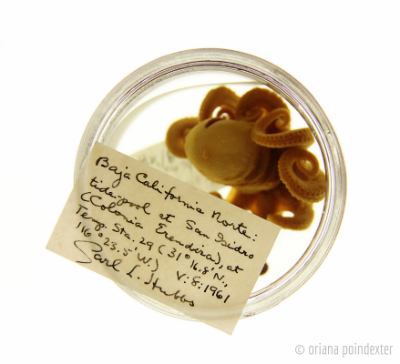
Oriana Poindexter – I’ve always had a serious attachment to the ocean, but I didn’t begin actively pursuing an ocean-related career until discovering the collections departments at the Scripps Institution of Oceanography (SIO). The collections are oceanic libraries, but instead of books, they have shelves of jars with every marine organism imaginable. My background is in visual art and photography, and the collections were a ‘kid in a candy store’ situation – I wanted to find a way to show these organisms as things of wonder and beauty, as well as invaluable learning tools for science. Photographing in the collections inspired me to immerse myself more intensely in marine science, joining the masters program at the Center for Marine Biodiversity & Conservation at SIO, where I had the opportunity to explore marine conservation from an interdisciplinary perspective.
Juliet Eilperin – One of the reasons I got into the ocean was frankly because it was under covered, and it was something that didn’t seem to attract a lot of journalistic interest. That provided me with an opening. It was something I thought was not only important, but also didn’t have many reporters who were as involved. One exception happened to be a woman — which is Beth Daley — who at the time was working with The Boston Globe, and worked a lot on marine issues. As a result, I certainly never felt disadvantaged for being a woman, and if anything I thought it was a wide open field because few reporters were paying attention to what was happening in the oceans.
Wendy Williams – I grew up in Cape Cod, where it’s impossible to not learn about the ocean. It’s home to to the Marine Biological Laboratory, and close by Woods Hole Oceanographic Institution. It is a fountain of fascinating information.
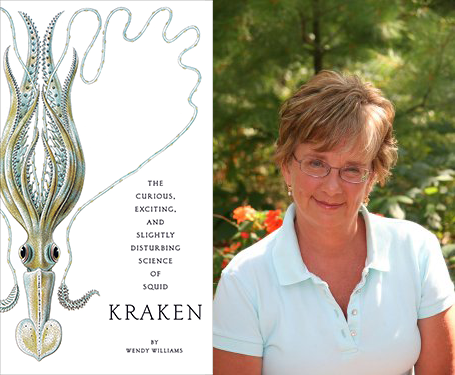
What continues to inspire you?
Juliet Eilperin – I would say that for me the issue of impact is always something that’s front and center. I certainly play it straight in my reporting, but any reporter wants to think that their stories are making a difference. So when I run a piece — whether its on oceans or other issues — I hope it reverberates and makes people think, or understand the world slightly differently. That’s one of the most important things to me. In addition, I am inspired by my own children who are still quite young but have grown up exposed to the ocean, to sharks, to the idea that we are connected to the sea. Their engagement to the water world is something that really influences the way I approach my work and how I think about things.
Erin Ashe – The fact that the whales are still imperiled and critically endangered is definitely a strong motivator. I also draw a lot of inspiration from doing the field work itself. In particular, in British Columbia, where it’s a little more remote and you’re seeing the animals without a lot of people. There aren’t these large container ships…I get lots of inspiration from my peers and going to conferences. I see what’s emerging in the field, what are the state of the art approaches to addressing those issues. I also look outside our field, listening to podcasts and reading about people from other sectors. Recently I’ve drawn a lot of inspiration from my daughter.
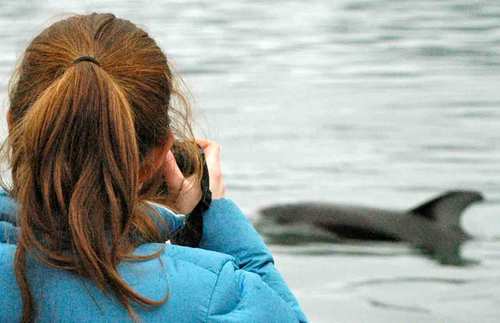
Kelly Stewart – Nature remains my main inspiration and sustains me in my life. I do love being able to work with students and I find that their enthusiasm, interest and excitement about learning to be invigorating. Positive people who project optimism instead of pessimism about our world also inspire me. I think our current problems will be solved by innovative minds who care. Taking an optimistic view of how the world is changing and thinking about solutions is so much more refreshing than reporting that the ocean is dead, or lamenting disastrous situations. Seeing past the depressing parts of conservation to the glimmers of hope is where our strengths lie because people get tired of hearing that there is a crisis that they feel helpless about. Our minds are limited sometimes in only seeing the problem; the solutions are just things we haven’t devised yet. And for most conservation issues, there is almost always time.
Ayana Elizabeth Johnson – The incredibly resourceful and resilient Caribbean people that I’ve worked with over the last decade have been a major source of inspiration. To me they are all MacGyver — doing so much with so little. The Caribbean cultures I love (in part due to being half Jamaican), like most coastal cultures, are so intertwined with the sea. My desire to help preserve those vibrant cultures requires preserving coastal ecosystems, so that is also a source of inspiration. The children that I’ve worked with are an inspiration as well — I want them to be able to have the same awe-inspiring ocean encounters that I have had, to live in coastal communities with thriving economies, and to eat healthy seafood.
Anne Marie Reichman – Life inspires me. Things are always changing. Every day there is a challenge to which I must adapt and learn from — being open to what is, what comes next. Excitement, beauty and nature inspire me. Also “the unknown”, the adventure, traveling, faith, and the opportunity towards change for the better are constant sources of inspiration for me. Other people motivate me, too. I am blessed to have people in my life who are committed and passionate, who live their dream and do what they love. I am also inspired by people who are confident to take a stand for what they believe in and take action where needed.
Rocky Sanchez Tirona – How committed local communities are to their ocean – they can be fiercely proud, passionate and creative about making solutions happen.
Oriana Poindexter – The ocean will always inspire me – to respect nature’s power and resilience, to be in awe of her infinite diversity, and to stay curious, alert, active, and engaged enough to experience it all firsthand. Surfing, freediving, and underwater photography are my favorite excuses to spend large amounts of time in the water, and never fail to inspire me in different ways.
Did you have any role models that helped solidify your decision to pursue a career?
Asher Jay – When I was really young I used to lug around a lot of David Attenborough, The Trials of Life, Life on Earth, etc. I remember looking at those pictures and reading those vivid descriptions and the colors and diversity he encountered, and I have just never been able to fall out of love with that. I have a bottomless, sensationble appetite for wildlife. I keep doing what I do because I was inspired by him at an early age. And more recently the kind of conviction with which Emmanuel de Merode (director of the Virunga National Park in the Democratic Republic of the Congo) operates and his program and way in which he has moved through with strong actions in the DRC, is something I find to be incredibly riveting. If he can do it I think anyone can do it. He has done it in such a powerful and passionate way, and he is so deeply committed that it really pushed me forward to be sort of on the ground, active conservationist as an ambassador for wild. One other person – Sylvia Earle – I just love her, as a kid she was a role model but now she is the family I never had! She is an amazing women, friend, and been a guardian angel to me. She is an incredible source of strength in the conservation community as a woman and I just really adore her…She is a force to reckon with.
Juliet Eilperin – In my experience covering marine issues, there are a number of women who play really prominent and critical roles in terms of both cutting edge science as well as advocacy. That became obvious to me from the very start of my tenure covering the environment. I talked to women like Jane Lubchenco, before she became the Head of the National Oceanic and Atmospheric Administration, when she was a Professor at Oregon State University, playing a very active role in mobilizing scientists to engage in policy issues through the Alpha Leopold Program. I also had the opportunity to speak with a number of shark scientists and experts, who happened to be women — whether it was Ellen Pikitch, Sonya Fordham (Head of Shark Advocates International), or Sylvia Earle. It’s interesting to me, because there are a lot of areas in which women encounter challenges in pursuing scientific careers, but I certainly found tons of female scientists and advocates who were really shaping the landscape and the discussion on some of these issues. Perhaps women became increasingly involved in shark conservation specifically because it didn’t get a lot of attention or study and it wasn’t commercially valuable for decades. That might have provided an opening for some women who otherwise might have encountered obstacles.
Ayana Elizabeth Johnson – Rachel Carson is an all time hero. I read her biography for a book report in 5th grade and was inspired by her commitment to science, truth, and the health of both humans and nature. After reading a much more detailed biography a few years ago, my respect for her deepened upon learning just how enormous the hurdles were that she faced in terms of sexism, taking on major industry/corporations, lack of funding, and being belittled for not having a Ph.D.
Anne Marie Reichman – I have many role models all over the place! Karin Jaggi was the first pro female windsurfer I met in South Africa 1997. She had won some world cup titles and when I met her she was nice, and happy to share some advice about the water she ripped! It gave me a boost to pursue my goal. In the paddling world of Maui, I became close to the community who would express competition but also care, safety and aloha for one another and the environment. Andrea Moller is definitely a role model in the community being inspiring in the SUP sport, one man canoe, two man canoe and now in the Big Wave surfing; besides that she is a great person, a friend and cares for others and the environment; always happy and passionate to give back. Jan Fokke Oosterhof is a Dutch entrepreneur who lives his dreams in the mountains and on land. His passion lies in mountaineering and ultra marathons. He helps realize people’s dreams and make them into reality. We stay in touch to tell each other about our projects, writings and passions and keep inspiring each other with our missions. My husband Eric is a big inspiration in my work in shaping surfboards. He sensed my interest and has been a big help and inspiration over the last few years. Our common passion for the ocean, creativity, creation, each other and a happy world is unique to be able to share in a relationship. I feel very lucky and grateful for all my role models.
Erin Ashe – Jane Goodall, Katy Payne — I met her (Katy) early in my career, she was a researcher at Cornell who studied elephants’ infrasonic sounds. She was a female scientist, so that really inspired me. Around that time I read a book by Alexandra Morton who went up to British Columbia in the 70’s and studied killer whales, and later on she became a real life role model. I met her and she shared her data on dolphins with me.
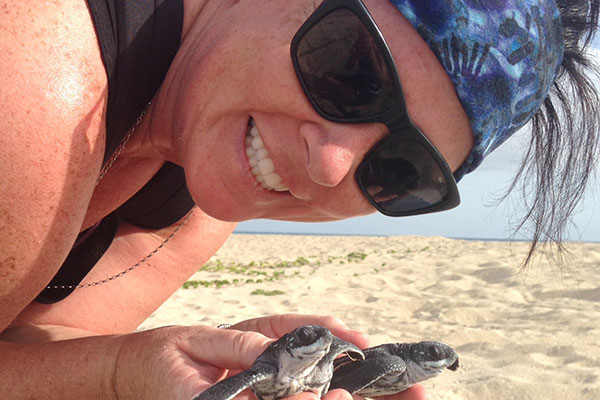
Kelly Stewart-I had a wonderful and varied education and a family who encouraged me in everything I chose to do. Writings by Henry David Thoreau and Sylvia Earle made me feel as though there was a place for me. At the University of Guelph (Ontario, Canada), I had interesting professors who had traveled the world in unconventional ways to study marine life. Early in my sea turtle work, conservation projects by Archie Carr and Peter Pritchard were inspirational. In graduate school, my master’s advisor Jeanette Wyneken taught me to think carefully and critically and my PhD advisor Larry Crowder had an optimism that encouraged me to succeed. I feel very fortunate now to still have many mentors and friends who confirm that this is the career for me.
Rocky Sanchez Tirona – Many years ago, I was very inspired by Sylvia Earle’s book Sea Change, but only fantasized about a career in conservation since I wasn’t a scientist. But over time, I met several women from Reef Check and other NGOs in the Philippines, who were dive instructors, photographers and communicators. I got to know them and decided I wanted to grow up like them.
Wendy Williams– My mother raised me to think I should be Rachel Carson (marine biologist and author)…And, researchers in general who are so passionately devoted to understanding the ocean are just people I love to be around… They really care about something…They are genuinely concerned about it.
View a version of this blog on our Medium account here. And stay tuned for Women in the Water — Part II: Staying Afloat!
Header image: Christopher Sardegna via Unsplash
